Adjectives of Feeling & Emotion ESL Games, Worksheets & Activities
Feelings Battleships

ESL Feelings and Emotions Game - Vocabulary and Speaking: Asking and Answering Questions - Pair Work
In this free adjectives of feeling and emotion game, students play battleships using family vocabulary and adjectives of feeling and emotion. In pairs, students start by marking four ships on their...
Feelings Bingo
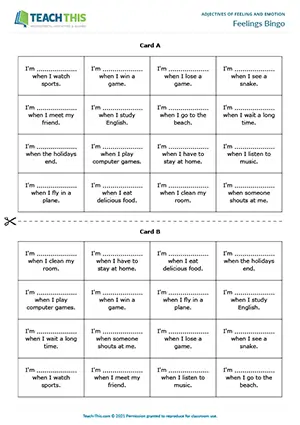
ESL Feelings Game - Vocabulary: Sentence Completion - Group Work
In this imaginative adjectives of feeling game, students play bingo by making true sentences about how they feel in certain situations. Students take it in turns to roll the feelings dice. The feelings dice shows the adjectives: happy, sad, scared, bored...
Feelings Vocabulary Workshop
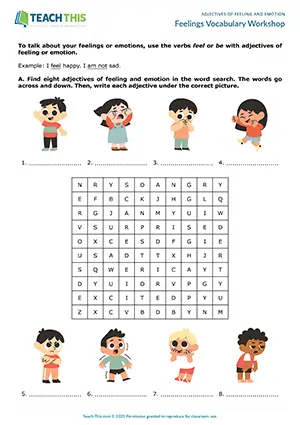
ESL Feelings and Emotions Worksheet - Vocabulary Exercises: Word Search, Matching, Gap-fill - Speaking Activity: Asking and Answering Questions - Pair Work
This engaging feelings and emotions worksheet helps students learn and practice eight adjectives of feeling or emotion. First, students find eight adjectives...
The Way I Feel
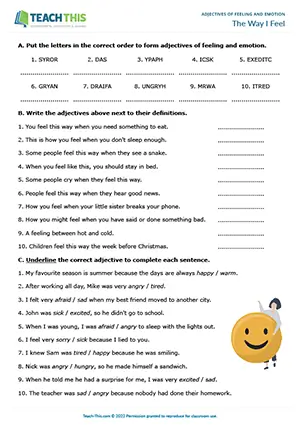
ESL Feelings and Emotions Worksheet - Vocabulary Exercises: Matching, Binary Choice, Gap-fill, Sentence Completion - Speaking Activity: Guessing - Pair Work
In this useful feelings and emotions worksheet, students practice common adjectives of feeling and emotion. First, students put letters in the...
Anna's Feelings

ESL Feelings and Emotions Worksheet - Vocabulary Exercises: Ordering, Identifying, Gap-fill, Categorising, Writing Sentences - Speaking Activity: Guessing - Pair Work
In this comprehensive adjectives of feeling and emotion worksheet, students practice 12 common feeling and emotion adjectives. First, students put a conversation in...
How were they feeling?

ESL Feelings Activity - Vocabulary and Speaking: Unscrambling, Matching, Guessing - Group and Pair Work
In this enjoyable adjectives of feeling activity, students describe how people were feeling at a party and match the descriptions with feeling and emotion adjectives. In two groups, students unscramble...
Adjective Association

ESL Feelings Game - Vocabulary: Word Association - Group Work
In this fun adjectives of feeling guessing game, students associate things with adjectives that describe feelings. In teams, students write down three things they associate with the ten adjectives of feeling shown on their worksheet...
Describe the Feeling
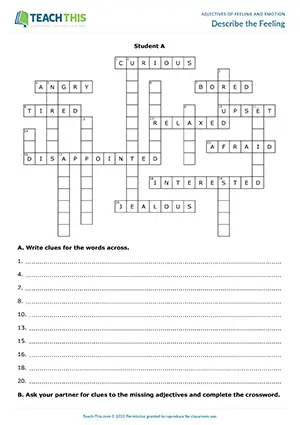
ESL Feelings and Emotions Crossword - Vocabulary Activity: Crossword, Writing Clues, Describing, Guessing - Pair Work
In this rewarding adjectives of feeling and emotion activity, students complete a crossword by describing and guessing feeling and emotion adjectives. In two groups, students invent and write...
How did you feel...?

ESL Feelings and Emotions Board Game - Vocabulary and Speaking: Asking and Answering Questions, Discussion - Pair Work
In this free adjectives of feeling and emotion board game, students practice describing how they felt the last time certain things happened to them. In pairs, students take...
I've got a Feeling

ESL Feelings and Emotions Activity - Vocabulary: Running Dictation, Gap-fill - Pair Work
In this productive adjectives of feeling and emotion activity, students take part in a running dictation where they dictate short texts and complete missing words with adjectives of feeling and...
Let's Talk About Our Feelings

ESL Adjectives of Feeling and Emotion Activity - Vocabulary and Speaking: Gap-fill, Asking and Answering Questions - Group and Pair Work
In this adjectives of feeling and emotion speaking activity, students complete, ask and answer conversation questions containing common adjectives of feeling...
Mixed Emotions
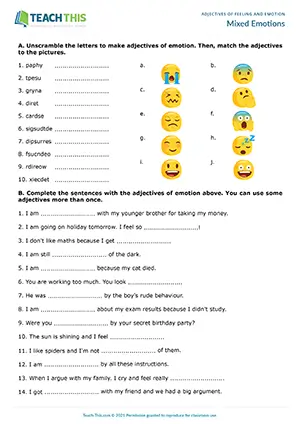
ESL Adjectives of Emotion Worksheet - Grammar and Vocabulary Exercises: Unscrambling, Matching, Gap-fill, Word Search, Writing Sentences
Here is an insightful adjectives of emotion worksheet for intermediate students. Students begin by unscrambling letters to make adjectives of emotion...
Close Encounters of the Third Kind
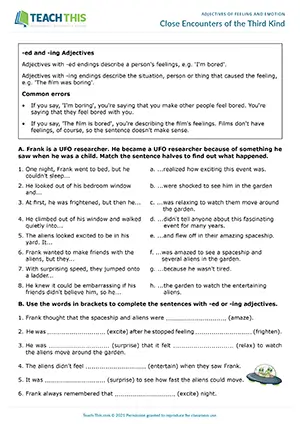
ESL Feelings and Emotions Worksheet - Vocabulary and Grammar Exercises: Matching, Gap-fill, Writing Sentences
In this interesting adjectives of feeling and emotion worksheet, students learn and practice -ed and -ing adjectives that describe feelings and emotions. To start, students match sentence halves...
How do I feel?

ESL Adjectives of Feeling and Emotion Game - Vocabulary and Speaking: Miming, Guessing, Forming Sentences - Group Work
In this engaging feelings and emotions game, students guess situations and related adjectives that describe feelings and emotions from mimes. Students take it in turns to pick up a card from the pile...
When did you last feel...?
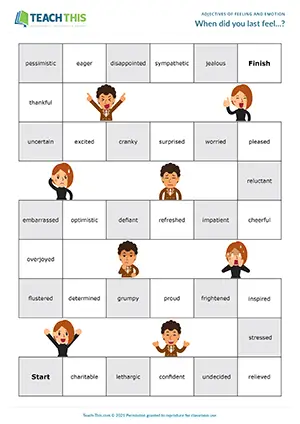
ESL Feelings and Emotions Board Game - Vocabulary and Speaking: True or False, Asking and Answering Questions, Guessing, Freer Practice - Group Work
In this entertaining adjectives of feeling and emotion board game, students review advanced adjectives of feeling and emotion by playing a board game where...

